The six works that are on view here, fall into two separate groups: three installations refer to sculpture whilst two installations and the tape refer to the art of painting. In the works that refer to the sculpture he doesn't restrict himself to what is only to be seen on the screen but also includes the monitor in the whole as a three-dimensional datum. The other group is especially distinguished by the fact that Schutter has wholly concerned himself with the screen.
In Related Forms the monitor is released from its function. The installation exists of two monitors which are put on top of each other. The one at the bottom is twice as large as the one on the top. The picture that is to be seen on the small monitor, gives the impression that it is completely filled with water and is slowly draining away. Initially on the large monitor there is nothing else to be seen other than a pale blue surface. Till a stream of water pours into the picture and appears to fill up half of the screen. It would seem that the water pours from the small monitor into the large screen. The effect of this is that the monitor seems more transparent and therefore the picture gets more depth. The monitors have become containers which one can look through. This spatial aspect gives the whole a sculptural character, whereas the video technique has still an essential function. Precisely by this technique is created the illusion of the pouring water and the so called process, once completed, can repeat itself.
Related forms obtains its power from the weird idea of monitors which are filled with water. This along with wanting to emphasize the compelling form of the monitor was one of the Starting-points of the artist. For though he's not able to define it himself, there is an opportunity to make changes by combining the given formats. Much thought is given here to the exploitation of this possibility.
Related Works - Schutter, Bert. 1980. Published in Mediamatic magazine Vol. 1#1 (1986)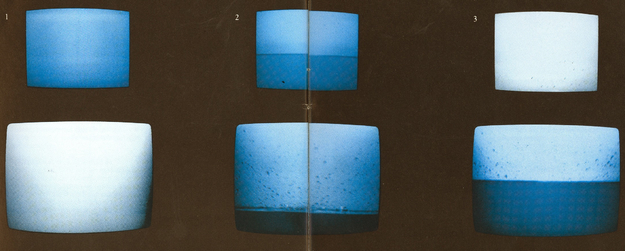
Woodsculpture appears more statical than Related Forms but there are also similarities between the two installations. Woodsculplure is constructed out of five monitors each with a walnut case, which are piled upon each other. They all show the same picture: a part of the trunk of a walnut tree. When you look at the installation as a whole the pictures seem to flow into each other and to form one whole trunk. The suggestion of images which appear to be connected to each other, you also find in Related Forms. As well as the images the monitor cases also form a whole which reminds one of a trunk of a tree.
Bert Schutter calls this installation a dual sculpture. By that he immediately indicates the relation with the art of sculpture. The sculptural part and the video part are here also presented as equal to each other. The fascinating thing about this installation is that a sculpture has been produced with on the one hand elusive material, being the video pictures and on the other hand with very massive elements, being the monitors themselves. In this manner the sculpture achieves an extra dimension whereas it clearly still remains a sculpture. If one would approach Woodsculpture as a video work of art, one would be immediately struck by the immobility and the special position of the screens. The screen isn't a window through which you see different scenes within a certain process of time, but rather matter. It is not the most obvious way to apply video technique. The advantage it offers, like being able to display movement and working with time, are left unused.
Woodsculpture - Schutter, Bert. 1980. Published in Mediamatic Magazine Vol. 1#1 (1986)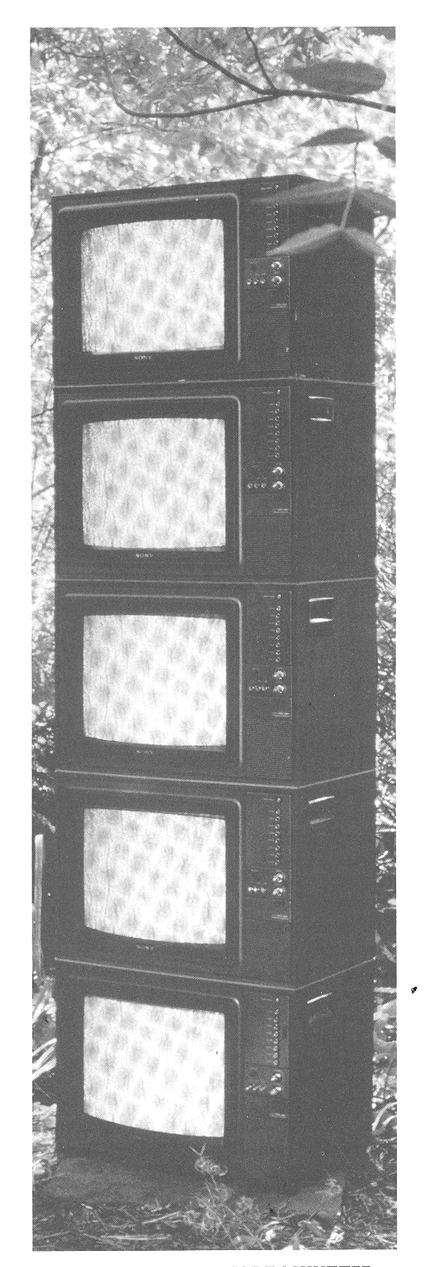
Still Woodsculpture exists by the grace of that technique. It is just as with Related Forms applied in an unusual manner and is just as inevitable. Besides which you could regard that emphatic absence of movement in a video sculpture as an impulse for the spectator to begin to think about that movement, to give oneself an impression of the work with pictures that actually do move. The movement is in this manner implicitly brought into discussion. So video and sculpture give something extra to each other, through which a work of art is created which finds itself in the region between the two.
The most aesthetical installation from the series which is reviewed here, is without doubt Escultura. For this installation only one monitor is used. Over the monitor a ' marble casing is placed, in which a piece the size of the screen is omitted. On the screen is to be seen the omitted piece with the inscription ESCULTURA upon it. Now and then the picture slightly undulates. The whole is placed upon a long black socle. Along with the video picture the lapping of water is to be heard. The beauty of Escultura especially seems to lie in the closed within itself character of the installation. Of the separate elements from which this work of art is built up no single one dominates. The casing and video picture complete each other, they form one entity. This is further emphasized by the fact that the drawing of the marble casing flows over into the piece that is to be seen on the screen.
Within this whole there are also contradictions expressed: soft as opposed to hard and mobile as opposed to statical. The hard, statical is expressed by the casing and the video part by the soft and mobile. The marble is tangibly present but at the same time elusive and tenuous. Similar contradictions are to be found in Woodsculpture. Another similarity is that in Escultura the video picture is also matter. Yet in Esculcura this matter is much more clearly transformed and stripped of its original qualities. New qualities~ the movement and the producing of sound, are attributed to the marble by the specific possibilities of the medium video. Escultura too stands midway between video art and sculpture, though differently to each other than in Woodsculpture. There the media video find sculpture are suited to each other whereas in Escultura each medium keeps its own characteristics whilst at the same time being an extension of the other. However, in this the spectator needs no longer form an idea of a possible movement in a statical sculpture, for in the case of Escultura it already exists.
Still Life/Still Alive - Schutter, Bert. 1981. Published in Mediamatic Magazine Vol. 1#1 (1986)
Still Life / Still Alive belongs to the series of videoworks which relate to the art of painting. Three monitors stand in a line and each monitor displays the picture of a bunch of tulips. Of the in total seventy five minutes long take, the first monitor shows the first twenty-five minutes, the second shows the next twenty-five minutes and the third the last twenty-five minutes. Each part of the recording differs, because the bunch has bloomed during the recording. By creating in this manner a still life Schutter displays the contradiction that is related to the idea still life: the movement is only apparently absent. By means of the video technique a still life is created in which the presence of movement within a still life is established.
In this installation the sculptural aspect is absent. It is the video pictures that are important, the monitors are only functioning as conveyor. The first three installations have an object-like character whereas Still Life/ Still Alive renders a linear development. This last aspect certainly characterizes the tape Neige à Louveciennes. Also here everything is enacted within the confines of the screen. The tape has been produced with the help of the key technique. Falling snowflakes gradually form a new picture: the painting Neige à Louveciennes that represents a snowlandscape and was made by the Impressionist Pissarro. An existing painting is created in a new manner, by means of a video effect. There is certainly a similarity to trace between the style of Pissarro and Schutter as far as the build up of the scene is concerned. The manner in which the falling snowflakes cover the surface evokes the manner in which the Impressionist applied the paint on the canvas.
Escultura - Schutter, Bert. 1983. Published in Mediamatic Magazine Vol. 1#1 (1986)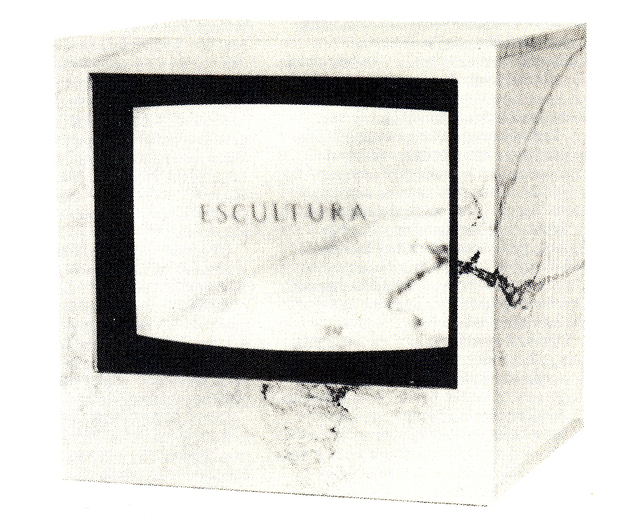
By reproducing with this picture the sounds that he and his technician made during the recording, Schutter builds up the suspense between the process of producing the tape (sound) and his interpretation of the making of the painting. Here he also introduces the phenomenon time: the spectator receives gradually an increasing number of pieces of information, which satisfy whilst at the same time stir his curiosity. That the manner in which the picture is formed refers to the contents, is only apparant after a period of time. Unlike Still Life / Still Alive in Neige à Louveciennes there is even more clearly talk , of a linear development with a start and an end.
In his next and most recent work Straat van Gibraltar, the accent is also on the picture and its manipulation of it. The installation has more the character of a situation than of a video sculpture. Two monitors, both placed back to back on stands. On each monitor there are approximately twenty five drawings to be seen one after the other. Every time a new drawing gradually fills the screen by causing the other to disappear. From top to bottom the drawing is once again built out of horizontal lines until it is completed then the next picture begins and slowly covers the first. The drawings represent the Strait of Gibraltar viewed twenty five times from the Moroccan coast and viewed twenty five times from Spain. On the wall behind the monitor with the seascapes from Spain hangs a photograph of the Strait of Gibraltar seen from the Spanish coast. Behind the other monitor there is a photograph of the Strait of Gibraltar seen from the Moroccan coast. On each video tape the sound of the appropriate beach has been recorded.
Neige a Louveciennes - Schutter, Bert. 1984. Published in Mediamatic Magazine Vol. 1#1 (1986)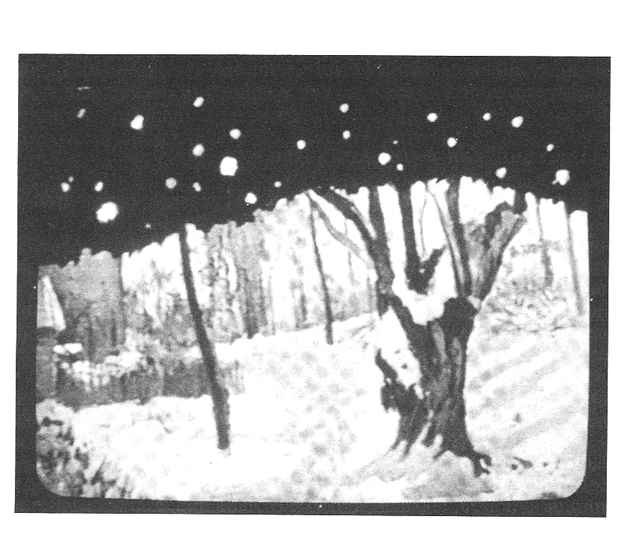
During the drawing of this Bert Schutter has used various techniques to indicate that water always appears the same even though it is always different. In a commentary on the installation Schutter once referred to Monet who produced series of paintings on one subject with an ever changing light and angle of incidence. In Straat van Gibraltar the connection with painting is present once more. Just as with Neige à Louveciennes the process of painting is especially illuminated: one can consider the photographs as that what the painter sees and the video pictures as that what he records. This accent on the process brings along that Straat van Gibraltar also again renders a linear development.
This approach of time characterizes all of his work that refers to the art of painting. In the video sculptures there is a different dealing with time. In these he doesn't introduce a dramatical development but he researches the motionlessness that is inherent in products of sculpture. What Still Life / Still Alive, Neige à Louveciennes and Straat van Gibraltar have also in common, is that the screen plays a more important role than in most other cases. In the latter two works there is a more complicated manner of intervention of the picture than in the first. They seem to be provided with a handwriting that together with concept defines their image. The other works only display the method of the artist through the concept. The most recent work of Schutter is therefore slightly more orientated on the flat surface, more on a small scale and less detached.
Straat van Gibraltar - Schutter, Bert. 1984/85. Published in Mediamatic Magazine Vol. 1#1 (1986)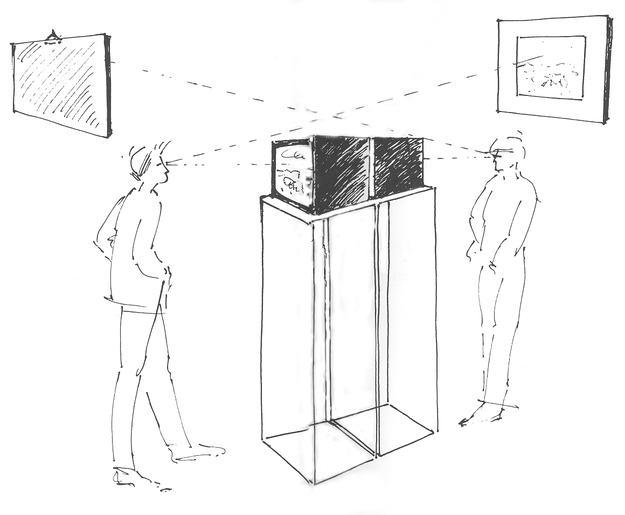
The installation Related Forms derives its charm mainly from the idea and the effect of that idea. Also with Woodsculpture and Escultura the concept takes on an important role. Much attention has been paid to the composition which is very tight, but still it remains less important. Through this manner of presentation the point of the three installations is crystal-clear.
Still Life / Still Alive is a concept that only manifests itself by way of the screens. It's a completely different concept than that of the video sculptures, because time is treated differently.
Neige à Louveciennes distinguishes itself from the previous pieces because on a smaller scale the picture is more intensively worked upon. What's more one can not recognize the idea at a glance. Accordingly as the picture gets more complete, the better the concept filters through. In Straat van Gibraltar the picture is also worked upon intensively and the comprehensibility of the concept is again related to the changes that the picture ondergoes, although the event extends further than the video pictures. The concept and the form are interwoven with these two pieces, whereas in the other examples the form serves to clarify the concept.
Straat van Gibraltar - Schutter, Bert. 1984/85. Published in Mediamatic Magazine Vol. 1#1 (1986)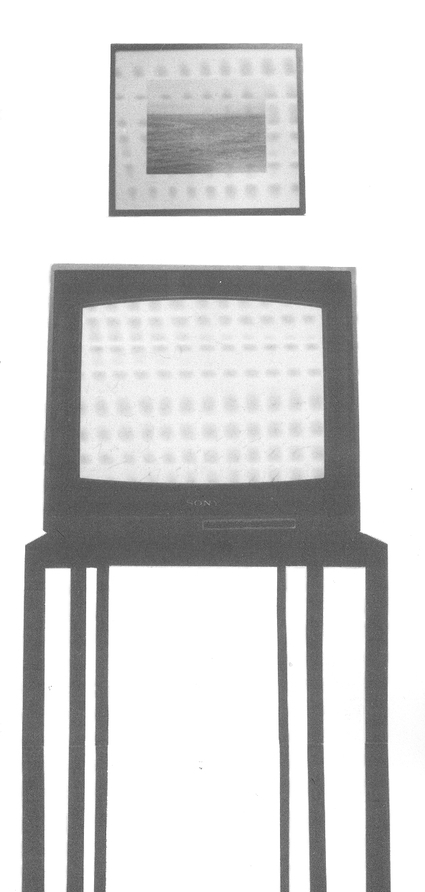
However every work has in common a perfect elaboration of a lucid concept and very refined aesthetics.
If you'd like to quote something: Rajandream, Marie-Adèle. "Bert Schutter six Works." Mediamatic Magazine vol. 1 # 1 (1986)
Translation: 'Grand Prix' Groningen